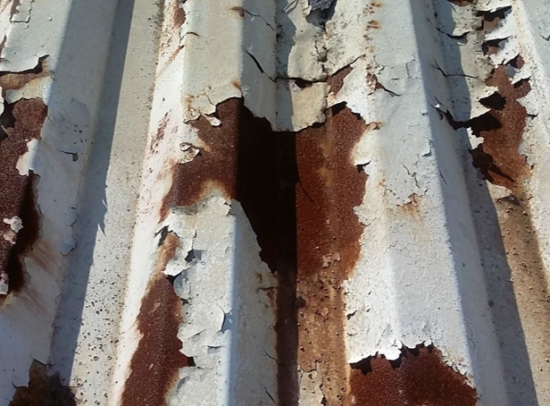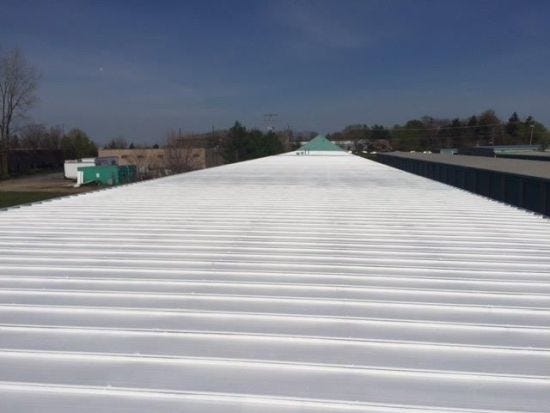Ensuring Long Life for Your Self-Storage Metal Roofs
The key to ensuring the lifespan of a self-storage metal roof is to catch and fix issues before they become major problems. Learn the common points of roof failure and how to avoid them.

Congratulations! You need a repair to your self-storage facility’s metal roof. Why congratulate you? Well, because if you caught the issue at a point where it can be repaired, you just saved yourself a lot of money.
The first point of emphasis in any discussion about metal-roof maintenance is if it can be fixed—and it usually can—it means your roof still has remaining useful life. And extending roof life is key to minimizing building-maintenance costs. Timely, thorough repairs that minimize callbacks are much, much less expensive than running a roof to failure and incurring the burdensome cost of a replacement.

An example of severe rusting on a metal roof panel
Common Points of Failure
When it comes to self-storage roofs, metal is by far the most popular choice. It’s quick and easy to install, and depending on the type of system, it can be relatively inexpensive. It’s also low-maintenance—but that doesn’t mean no maintenance. You can’t install a metal roof rated to last up to 30 years and simply expect it to perform that long without timely intervention and regular attention.
The keys to avoiding common problems are awareness, correct installation, and proper adhesion to recommended care and maintenance guidelines. Let’s examine some common points of failure associated with metal roofs and how to avoid them.
Loose fasteners. R-panel metal roofs are among the most commonly used in self-storage. They’re potentially the least expensive in terms of upfront cost and have an appealing appearance.
That said, R-panel roofs often have exposed fasteners every few square feet on the horizontal and vertical laps to attach to the building. Because these fasteners don’t account well for the movement or expansion of the building over time, they tend to loosen, which can be problematic. Issues can range from rust to leaks to mold. Ultimately, damage can occur inside the storage unit itself. Any time you’re on the roof performing repairs or an inspection, check the nearby fasteners and be proactive in replacing any that are damaged or loose.
Lack of insulation. When installing a metal roof, preventing condensation is important, even if the storage building isn’t heated. If there are lights close to the ceiling that don’t use newer, low-heat bulbs, the warmth generated can cause condensation. Essentially, if there’s any temperature differential between the inside of the unit and the outside air, the roof should be insulated before the panels are installed. A lack of insulation, along with breaks in insulation or insulation that becomes wet, can result in too little thermal resistance to prevent condensation or achieve energy savings.
Incorrectly sealed or non-sealed seams. Sometimes, metal-roof seams aren’t sealed correctly or at all. Any contractor that understands metal will know how important it is to apply sealer (caulk or butyl tape) inside each seam. R-panel seams are typically lapped and fastened, while inverted-J and trapezoidal panels are typically seamed mechanically. A hand seamer is often required to finish the final foot or two of a panel. This is often where problems arise if it isn’t done properly.
Dissimilar metals. Using dissimilar metals, such as aluminum fasteners against galvanized-steel panels or trim pieces that aren’t the same metal as a panel, can result in corrosion and even compromise the integrity of the roof system.
Missing or damaged closures. Closure strips help fill the gaps between roof panels and the roof deck at the end of the panels. While they’re fairly inexpensive, they can be a little difficult to access and replace when damaged. Shooting foam, caulk or cement into these areas are examples of temporary fixes unlikely to resolve the problem. A proper repair involves removing or loosening panels and gutters to access and replace the closure strip itself.
Scratches. If someone drags equipment or tools across the roof, it can cause scratches that, over time, will start to rust. In these instances, apply a rust inhibitor to keep it from worsening.
Inflexible repair products. When performing metal-roof repairs, refrain from using aluminum coating or asphaltic cement because they don’t have enough elongation. As the metal panels move, the asphaltic product will begin to separate from the metal, creating air space. The resulting trapped moisture can cause rust. Typically, the more elongation the better when it comes to repair products. You’ll get that performance using products with elastomeric properties.
Light foot traffic. Walking on metal-roof panels can crimp them, causing creases on vertical seams. A creased panel can become cut and lead to rust or leaks. Minimize foot traffic where you can, and be mindful of the damage it can cause.

A restored metal roof
Warranty Issues
Warranties on new and repaired metal roofs can be confusing, causing misunderstandings when it comes to filing a claim. Warranties are commonly based on the performance of the finish as opposed to anything related to waterproofing. Be wary and ask questions about your warranty to avoid surprises down the road. If you’re getting a 20-year finish warranty, you’d be wise to get a 20-year waterproofing warranty as well.
Be mindful about coverage as much as its duration. Though the warranty may be for 20 years, it might not cover what you’d expect, or it may include so many exclusions that it ends up not being practical. For example, most metal-roof warranties won’t cover incidental or consequential damage, such as items inside a storage unit ruined due to a leak.
There are typically two kinds of warranty repairs: a repair-only warranty and a leak-location warranty. Repair-only looks at the specific repair itself, while a location warranty goes a step further by covering a more comprehensive area around the suspected origin of the leak. These are often offered only with repairs that include a more expansive, thorough process.
Minimize Damage
If you limit roofing issues to what’s repairable or restorable, you likely won’t ever have to do anything more invasive. However, as a qualifier, it’s key to ensure any issue is a “proper repair,” because unless it’s with an obvious problem area—which is a rarity with metal roofs—it may not be isolated to a specific point. This necessitates a thorough repair, not a quick, Band-Aid fix.
Because a roof leak on a metal roof can be tricky to find, diagnosing often becomes a process of elimination. The best practice is often to address a wider area than the suspected leak point by thoroughly repairing everything questionable in that section of roof. This typically involves fixing fasteners, seams and penetrations for multiple panels. Though this can lead to slightly higher repair costs, it minimizes the likelihood for a return service call (and the additional expenses that go with it) when the leak inevitably returns in a nearby section a short time later.
The bottom line to saving money and maximizing the life of a metal roof is to be aware of common issues, address them when they occur, and invest in the proper repair to avoid repeatable problems and service callbacks. While metal roofs are proven to last a long time and be relatively low-maintenance, it’s prudent to understand where and when things can go wrong and the resulting consequences that can occur if unaddressed.
Anthony Vross is a co-owner of Simon Roofing, a national roofing manufacturer and contractor. The company provides roof-asset management, evaluation, preventive maintenance, repairs, restoration and replacement. For more information, call 888.353.7178; visit www.simonroofing.com.
About the Author(s)
You May Also Like





